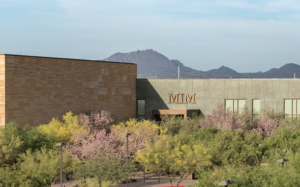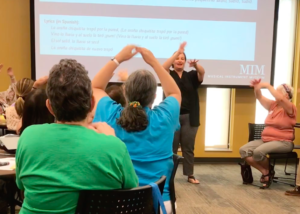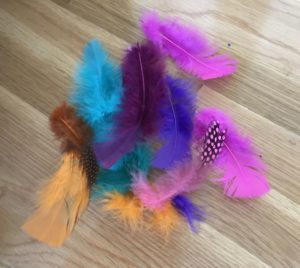October can be a month of opposites. Where I live, sometimes the weather is warm in October, and sometimes it feels quite cold. Sometimes the wind blows softly and sometimes it’s loud, whipping and whistling through the trees. Sometimes the leaves move fast, dancing and whirling, and sometimes they float down slowly.
I posted here last week about using music, movement and poetry to teach about the opposites loud and soft, and fast and slow. Dynamics and tempo, of course, embody two types of musical opposites.
I recently had a chance to experience another opposite-related lesson while attending a workshop with members of The Children’s Music Network at the Musical Instrument Museum (MIM) in Phoenix, AZ. Katherine Palmer, the museum’s Curator of Education, demonstrated musical play with the use of feathers. She learned this activity from Jo Kirk, a teacher in the Kodaly musical pedagogy.
Ms. Palmer discussed how she passes out feathers to children in a music class, asking children to examine the feathers and describe their characteristics. (The feather is soft, it’s light.) In an opposites lesson, the teacher can ask the opposites of “soft” and “light.”
Children are asked to hold the feathers high in the air, then let them drift to the ground. As the feathers descend, the teacher and others can sing descending pitches. This easily leads to discussion of more opposites (high and low, up and down, fast and slow).
Children can also be asked to catch the feather as it’s dropping, and to place the feather on the back of their hand or some other body part. Then the teacher challenges the children to move, while not letting the feather fly away. They soon discover that this movement must happen very slowly!
Part of the purpose of the feather lesson is to observe and assess how children move through space. Are they in control? Can they move slowly and keep the feather from falling? Do they have the mastery of hand-eye coordination to catch the feather? These are interesting questions in any classroom, not just in music.
Can I just take a moment to say what an awesome educational resource the Musical Instrument Museum is? It’s a wonderful resource for exploring world cultures through music, but is also a goldmine for educators. Their web page includes curriculum guides for a variety of topics, including lessons such as this one. Just click on this link, and scroll down to Sounds All Around and then to Arts-Integrated Movement: Musical Play Through Feathers.
After visiting MIM, I tried the feather lesson with some of my preschool music students. They had fun with the feathers and it did provide an opportunity to assess the skills above, and to see what everyone knows about opposites.
The feather lesson opens up opportunities to explore different styles of movement (floating vs. sharp/quick, or in musical terms, legato vs. staccato). It also can lead into teaching about high and low pitches and scales.
For exploring high and low pitch relationships (as well as the life cycle of a butterfly), I recommend my song, “If I Were a Butterfly,” which features a butterfly fluttering high and low. The notes in that part of the song correspond with the butterfly’s flight. I taught this song earlier in the fall, and one group of children asked to return to it today! Another terrific high/low song is Nancy Hershatter’s “Once I Was a Seed,” in which children can move from low to high on an ascending scale. I enjoy teaching this one in the spring. As October winds whip outside my house, spring seems like a long time from now.
Meanwhile, one more plug to encourage you to sing this fun song, which I wrote about ten years ago: The Opposite Game! Listen to it on my CD, Singing All the Way Home and you’ll find a fun way to build some vocabulary and encourage quick thinking on opposites.








What a lovely, multifaceted activity, Liz. Thank you for sharing!
I have already applied the Opposite Song and have found it to be a great tool for working with children on the autism spectrum. The lyrics provide direct prompts on when to respond. It allows for pauses in the rhythm so the response can be on the students’ time. The pitch is simple and accessible for those of limited speech. The concept can foster connective thought and creativity. During the lesson, my student chose a word for me to say opposite, “Hamburger”. “What is the opposite of Hamburger?”, I asked. He said,”Pizza!”. You learn something new everyday.
Thanks Liz, Two thumbs UP